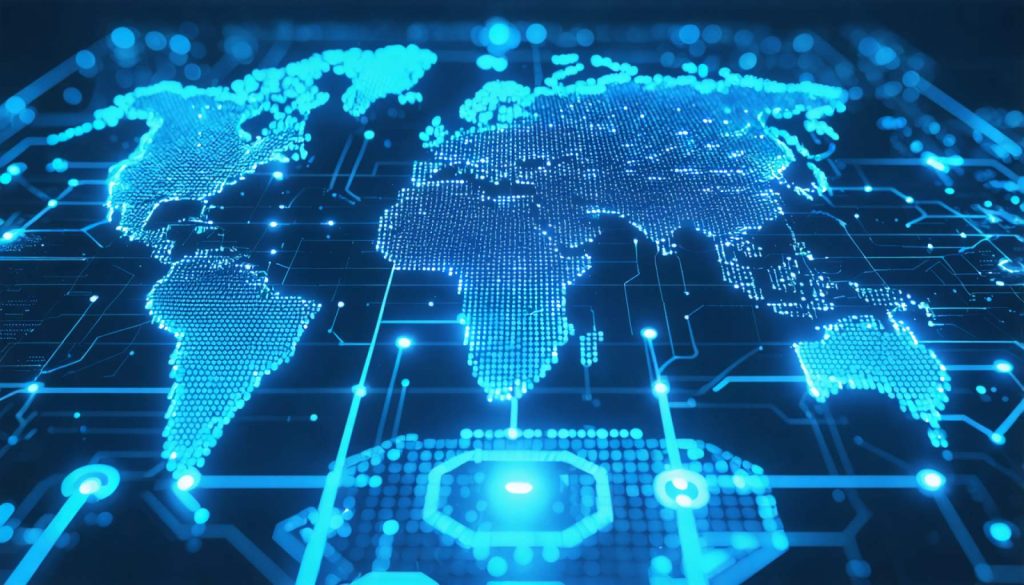
- The introduction of a 54% tariff on Chinese imports threatens global trade, affecting sectors like technology and manufacturing.
- Key materials, such as gallium and germanium, could face supply challenges, impacting tech supply chains.
- DeepSeek, a Chinese AI pioneer, remains largely unaffected by tariffs due to its focus on digital products, like AI models and software, which are not subject to traditional import fees.
- The company relies on intellectual labor rather than physical manufacturing, reducing its dependency on disrupted mineral supplies.
- Despite avoiding tariff impacts, DeepSeek faces potential regulatory challenges from the U.S., concerning data security and AI access.
- The U.S. Commerce Department has restricted DeepSeek’s software on governmental devices, hinting at future restrictions.
- The situation highlights the complex interplay between digital innovation and geopolitical concerns in global trade.
A looming shadow darkens the economic horizon as new tariffs, introduced by former President Donald Trump, threaten to ignite a global trade standoff. The imposition of a sweeping 54% tariff on Chinese imports paints an uncertain future, sending ripples through the corridors of technology and manufacturing. From semiconductors to solar cells, vital materials such as gallium and germanium face potential bottlenecks, casting a long shadow over traditional tech supply chains.
However, in this age of uncertainty, one Chinese company glides with apparent ease past these stormy economic seas. DeepSeek, a trailblazer in AI innovation, deftly maneuvers through the turbulent waters, its buoyancy stemming from two pivotal strategies.
First, DeepSeek’s forte lies in digital realms—AI models and software—that transcend the physical confines subject to conventional tariffs. Their offerings, unlike tangible goods, are ethereal constructs of data and algorithms, dynamic and immune to the shackles of import fees. The buoyancy of their business hinges on intangibles where bytes and nodes form the landscape, unburdened by traditional trade constraints.
Second, the company’s labor rests not on assembling silicon or weaving fiber optics, but on the nuanced development of AI and agile data processing. Their infrastructure leans heavily on intellectual acumen rather than bricks and mortar factories, allowing them to sidestep the crippling reliance on Chinas’s disrupted mineral supplies.
Yet, the immunity of DeepSeek is a complex tapestry. The undercurrents of geopolitical tension suggest potential risks: the US might tighten its grip through regulatory oversight, probing the flow of data and access to AI systems from international shores. National security voices speak in hushed tones about the potential hazards lurking within foreign technology, highlighting the specter of unsanctioned data access or manipulation.
Indeed, whispers from governmental corridors forewarn restrictions that could curtail the usage of DeepSeek’s sophisticated models within US borders. Already, the U.S. Commerce Department has shielded its governmental devices from DeepSeek’s software, fueling conjecture over future safeguards.
While traditional tariffs have bypassed DeepSeek’s digital dominion, the specter of regulation looms large. As questions whirl around data sovereignty and security, the path ahead for global AI integration will test the balance between innovation and safeguarding national interests.
The emerging reality is that digital goods, unbound by the tariff shackles, are not devoid of the geopolitical chess game. The way DeepSeek navigates these waters will offer more than just insights into overcoming tariffs—it will test the blueprint of how digital empires tackle nationalistic boundaries in an ever-globalized world. The challenges of today urge a reevaluation: ensuring that tech innovation marries harmoniously with security imperatives and economic realities.
In this evolving landscape, our collective gaze must shift—as spectators and stakeholders alike—to the boundless frontier of digital trade where new rules are yet to be written.
Adapting to a New Era: How DeepSeek and Others Navigate Tariff Wars and Digital Frontiers
Unpacking the Economic Landscape
Amid the turbulence stirred by new tariffs on Chinese imports, the tech and manufacturing sectors are bracing for potential disruptions. The 54% tariff threatens to impact a wide array of products, from semiconductors to solar cells, which are crucial for industries worldwide. Materials like gallium and germanium, essential for technological advancements, might face supply chain constraints, pushing companies to seek alternative strategies.
Understanding DeepSeek’s Strategic Resilience
DeepSeek, a prominent name in AI innovation, has adeptly sidestepped the direct consequences of these tariffs. Here’s how:
1. Digital-First Approach: By focusing on AI models and software, DeepSeek avoids the physical goods subject to tariffs. Their core products are intangible, residing in the realms of data and algorithms, which are not encumbered by import duties. This positions them advantageously against traditional competitors reliant on tangible goods.
2. Skilled Labor Over Manufacturing: DeepSeek invests heavily in intellectual expertise rather than physical facilities. This reduces their dependency on disrupted mineral supplies necessary for manufacturing, enabling them to maintain a steady course despite geopolitical upheavals.
Anticipating Regulatory Challenges
However, DeepSeek’s navigation is not without potential pitfalls. As geopolitical tensions rise, the U.S. may increase regulatory scrutiny over foreign technology firms, including DeepSeek. Key areas of concern are:
– Data Security: With heightened focus on national security, there is growing apprehension about potential unauthorized data access or manipulation by foreign AI systems.
– Access Restrictions: Speculation surrounds future U.S. measures that could limit deployment of DeepSeek’s technology on American soil, impacting its market penetration.
Insights and Industry Trends
How-To Steps & Life Hacks:
– Diversification: Companies should consider diversifying supply chains and exploring alternative sourcing options to minimize tariff impacts.
– Intellectual Capital: Investing in intellectual talent and R&D can reduce reliance on traditional manufacturing processes susceptible to tariffs.
Real-World Use Cases:
Tech companies can emulate DeepSeek’s model by leaning into software solutions, where digital goods facilitate global reach beyond the constraints of tariffs.
Market Forecasts & Industry Trends:
Experts suggest a trend towards digitization as more firms recognize the impermanence of physical trade channels. In the coming decade, AI and cloud computing are expected to contribute significantly to industrial innovation.
Reviews & Comparisons:
DeepSeek’s strategy can be contrasted with traditional manufacturers who face immediate tariff impacts. This highlights the growing divide between companies that embrace digital transformation and those that remain anchored to physical goods.
Security & Sustainability:
As data security becomes paramount, AI companies will need to prioritize secure data processing and ensure compliance with international regulations to maintain trust.
Actionable Recommendations
– Conduct Risk Assessments: Regularly evaluate how external factors, like tariffs and regulations, might impact your business, and adapt swiftly to new policies.
– Build Partnerships: Form strategic alliances with tech companies to bolster supply chain resilience and bolster digital capacity.
– Monitor Regulatory Changes: Stay informed about policy shifts that may affect data sovereignty and access to international markets.
Conclusion
DeepSeek’s journey underscores the evolving arena of global trade, where digital frontiers present both challenges and opportunities. As the rules of the digital economy are reshaped by policy and innovation, companies need to adapt quickly to maintain competitiveness.
For more insights into technological innovation and global business strategies, explore resources on McKinsey, a leader in business analysis and future trends.



